Validation of Car Parking System Design Using Sequence Diagrams
VerifiedAdded on 2023/06/11
|14
|2724
|403
Report
AI Summary
This report presents a validation of a car parking system design using sequence diagrams. It focuses on three key subsystems: ticket checking, ticket purchase, and payment. The sequence diagrams illustrate the interactions between actors and objects within these subsystems, detailing processes such as ticket validation, payment processing via card, and system responses to various user actions. The report also discusses system components like sensors, displays, ticket generators, and barriers. The diagrams are created based on the use case of the parking system, and the validation process ensures that the system meets the requirements for handling fixed and ordinary customers, managing data, and maintaining security. The study concludes that the sequence diagrams effectively visualize the system's processes and object interactions, facilitating the development of class diagrams and demonstrating the automated functionality of Collin’s car park system.

Running head: CAR PARKING SYSTEM
Assessment 3
Name of the Student
Name of the university
Author Note:
Assessment 3
Name of the Student
Name of the university
Author Note:
Paraphrase This Document
Need a fresh take? Get an instant paraphrase of this document with our AI Paraphraser
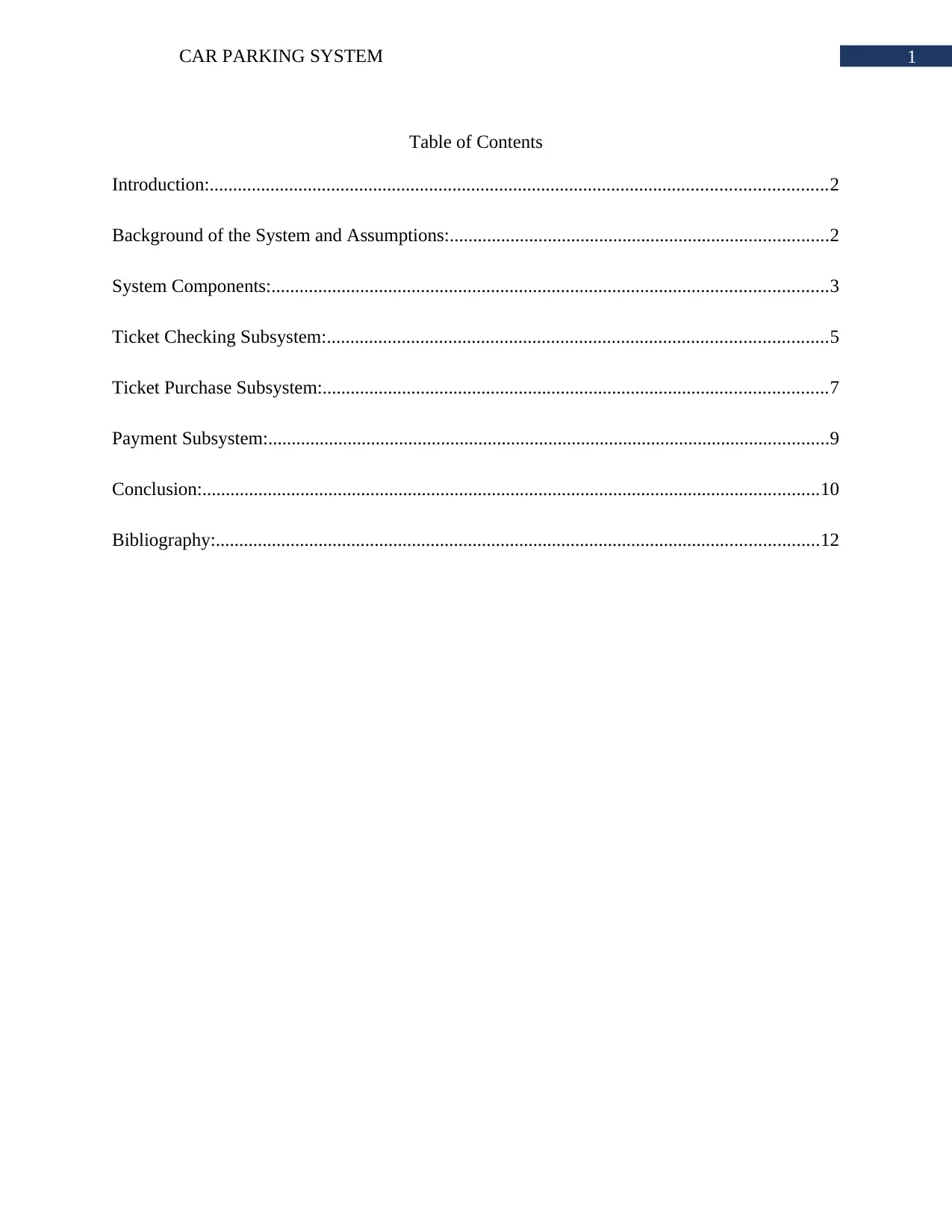
1CAR PARKING SYSTEM
Table of Contents
Introduction:....................................................................................................................................2
Background of the System and Assumptions:.................................................................................2
System Components:.......................................................................................................................3
Ticket Checking Subsystem:...........................................................................................................5
Ticket Purchase Subsystem:............................................................................................................7
Payment Subsystem:........................................................................................................................9
Conclusion:....................................................................................................................................10
Bibliography:.................................................................................................................................12
Table of Contents
Introduction:....................................................................................................................................2
Background of the System and Assumptions:.................................................................................2
System Components:.......................................................................................................................3
Ticket Checking Subsystem:...........................................................................................................5
Ticket Purchase Subsystem:............................................................................................................7
Payment Subsystem:........................................................................................................................9
Conclusion:....................................................................................................................................10
Bibliography:.................................................................................................................................12
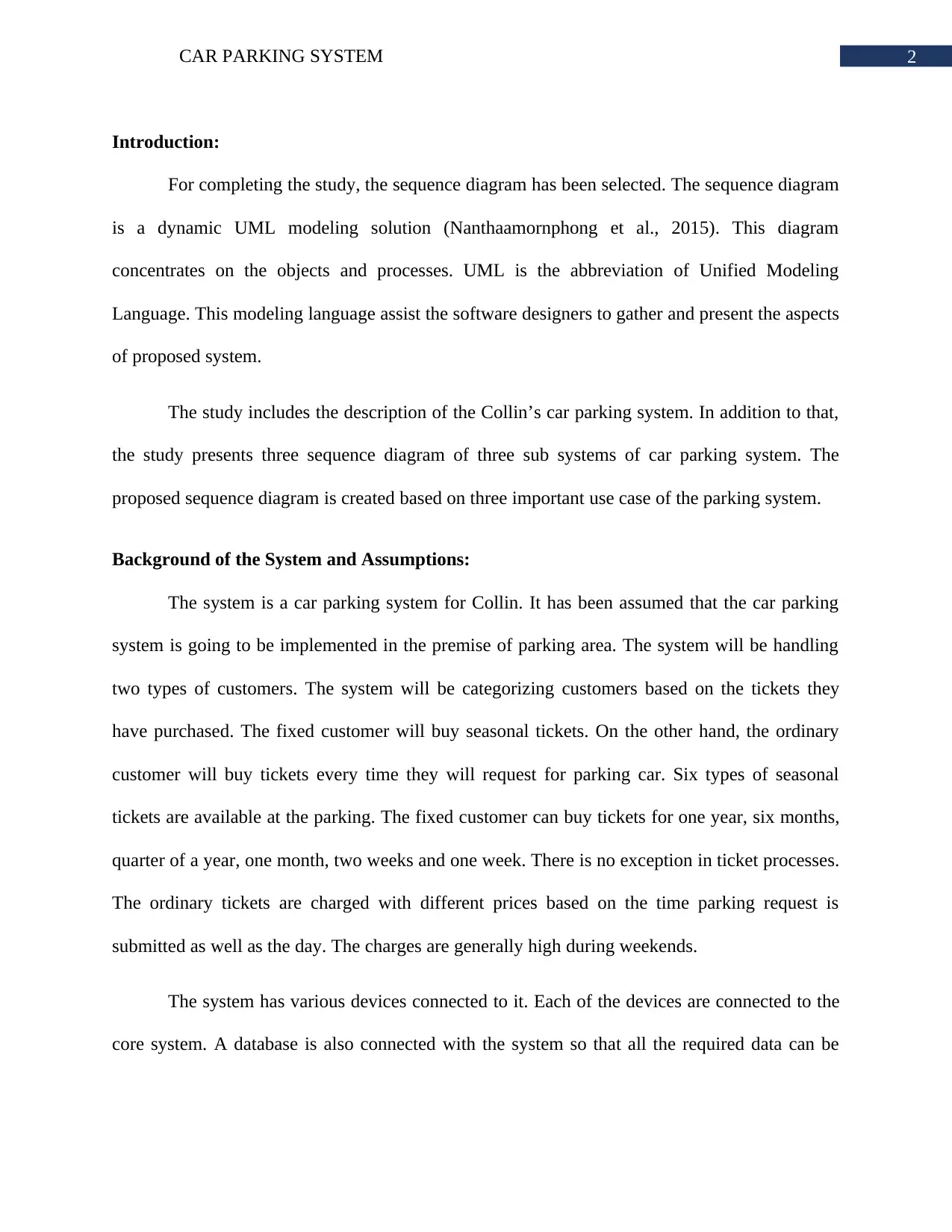
2CAR PARKING SYSTEM
Introduction:
For completing the study, the sequence diagram has been selected. The sequence diagram
is a dynamic UML modeling solution (Nanthaamornphong et al., 2015). This diagram
concentrates on the objects and processes. UML is the abbreviation of Unified Modeling
Language. This modeling language assist the software designers to gather and present the aspects
of proposed system.
The study includes the description of the Collin’s car parking system. In addition to that,
the study presents three sequence diagram of three sub systems of car parking system. The
proposed sequence diagram is created based on three important use case of the parking system.
Background of the System and Assumptions:
The system is a car parking system for Collin. It has been assumed that the car parking
system is going to be implemented in the premise of parking area. The system will be handling
two types of customers. The system will be categorizing customers based on the tickets they
have purchased. The fixed customer will buy seasonal tickets. On the other hand, the ordinary
customer will buy tickets every time they will request for parking car. Six types of seasonal
tickets are available at the parking. The fixed customer can buy tickets for one year, six months,
quarter of a year, one month, two weeks and one week. There is no exception in ticket processes.
The ordinary tickets are charged with different prices based on the time parking request is
submitted as well as the day. The charges are generally high during weekends.
The system has various devices connected to it. Each of the devices are connected to the
core system. A database is also connected with the system so that all the required data can be
Introduction:
For completing the study, the sequence diagram has been selected. The sequence diagram
is a dynamic UML modeling solution (Nanthaamornphong et al., 2015). This diagram
concentrates on the objects and processes. UML is the abbreviation of Unified Modeling
Language. This modeling language assist the software designers to gather and present the aspects
of proposed system.
The study includes the description of the Collin’s car parking system. In addition to that,
the study presents three sequence diagram of three sub systems of car parking system. The
proposed sequence diagram is created based on three important use case of the parking system.
Background of the System and Assumptions:
The system is a car parking system for Collin. It has been assumed that the car parking
system is going to be implemented in the premise of parking area. The system will be handling
two types of customers. The system will be categorizing customers based on the tickets they
have purchased. The fixed customer will buy seasonal tickets. On the other hand, the ordinary
customer will buy tickets every time they will request for parking car. Six types of seasonal
tickets are available at the parking. The fixed customer can buy tickets for one year, six months,
quarter of a year, one month, two weeks and one week. There is no exception in ticket processes.
The ordinary tickets are charged with different prices based on the time parking request is
submitted as well as the day. The charges are generally high during weekends.
The system has various devices connected to it. Each of the devices are connected to the
core system. A database is also connected with the system so that all the required data can be
⊘ This is a preview!⊘
Do you want full access?
Subscribe today to unlock all pages.

Trusted by 1+ million students worldwide

3CAR PARKING SYSTEM
stored for business purposes. The system will not hold the records of the customer who
purchases ordinary ticket, but fixed customer information are registered into the system.
System Components:
The system has mainly five components that are integral part of the daily process. The
sensors are the smallest part of the system which are installed within the pillars. These sensors
recognize any approaching car toward the gate. The sensor sends the signal to the core system
and the system generates an output on the display. All the IoT devices installed in the pillars are
connected to a microcontroller. This microcontroller handles the processes of the IoT and
communicate with the main system. The display in the pillar acts as the communication medium
between the customers and the system. The customer input the details, required to park the car,
and the system process those inputs to generate a result. The display will show a message after
every action to let the customer know whether the process is successful or not.
The ticket generator and ticket checker are integral part of the system. The ticket
generator works independently and only takes input from the core system. The system only sends
Boolean values and ticket code to the ticket generator. The ticket generator prints the code of the
ticket and the date on which it is created. The barriers are also a part of the system. The parking
system uses standard barriers that can operate on their own, that means these have own
microcontroller. The system only sends a signal to the barrier and the barrier rises or closes as
per the signal request. As the whole system is runs automatically, the use of the good quality of
microcontroller is recommended. Good quality microcontrollers can work very fast and
effectively on their own and generate desired results. The system can process other operations at
that time which will result in not only quicker response to user request but also better service.
stored for business purposes. The system will not hold the records of the customer who
purchases ordinary ticket, but fixed customer information are registered into the system.
System Components:
The system has mainly five components that are integral part of the daily process. The
sensors are the smallest part of the system which are installed within the pillars. These sensors
recognize any approaching car toward the gate. The sensor sends the signal to the core system
and the system generates an output on the display. All the IoT devices installed in the pillars are
connected to a microcontroller. This microcontroller handles the processes of the IoT and
communicate with the main system. The display in the pillar acts as the communication medium
between the customers and the system. The customer input the details, required to park the car,
and the system process those inputs to generate a result. The display will show a message after
every action to let the customer know whether the process is successful or not.
The ticket generator and ticket checker are integral part of the system. The ticket
generator works independently and only takes input from the core system. The system only sends
Boolean values and ticket code to the ticket generator. The ticket generator prints the code of the
ticket and the date on which it is created. The barriers are also a part of the system. The parking
system uses standard barriers that can operate on their own, that means these have own
microcontroller. The system only sends a signal to the barrier and the barrier rises or closes as
per the signal request. As the whole system is runs automatically, the use of the good quality of
microcontroller is recommended. Good quality microcontrollers can work very fast and
effectively on their own and generate desired results. The system can process other operations at
that time which will result in not only quicker response to user request but also better service.
Paraphrase This Document
Need a fresh take? Get an instant paraphrase of this document with our AI Paraphraser
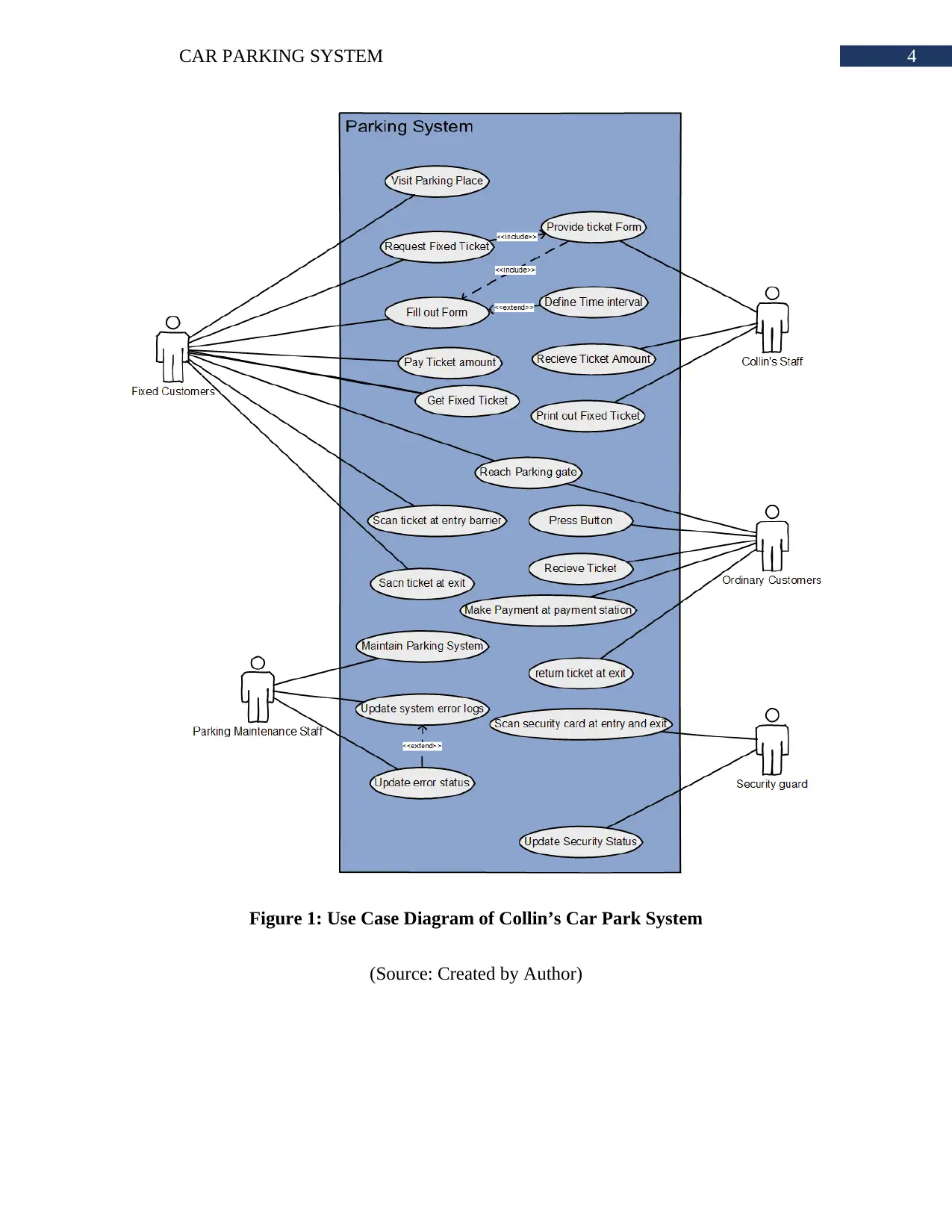
4CAR PARKING SYSTEM
Figure 1: Use Case Diagram of Collin’s Car Park System
(Source: Created by Author)
Figure 1: Use Case Diagram of Collin’s Car Park System
(Source: Created by Author)
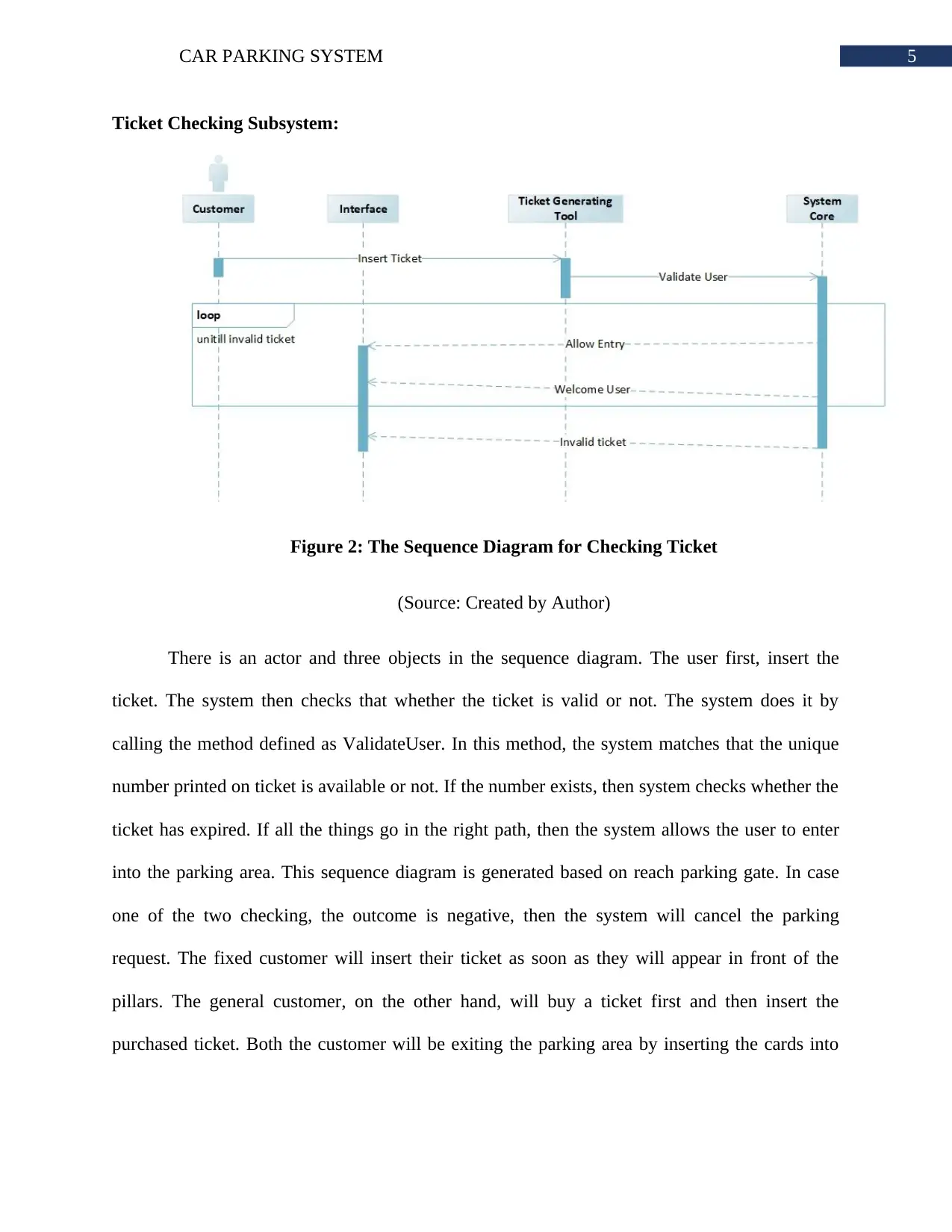
5CAR PARKING SYSTEM
Ticket Checking Subsystem:
Figure 2: The Sequence Diagram for Checking Ticket
(Source: Created by Author)
There is an actor and three objects in the sequence diagram. The user first, insert the
ticket. The system then checks that whether the ticket is valid or not. The system does it by
calling the method defined as ValidateUser. In this method, the system matches that the unique
number printed on ticket is available or not. If the number exists, then system checks whether the
ticket has expired. If all the things go in the right path, then the system allows the user to enter
into the parking area. This sequence diagram is generated based on reach parking gate. In case
one of the two checking, the outcome is negative, then the system will cancel the parking
request. The fixed customer will insert their ticket as soon as they will appear in front of the
pillars. The general customer, on the other hand, will buy a ticket first and then insert the
purchased ticket. Both the customer will be exiting the parking area by inserting the cards into
Ticket Checking Subsystem:
Figure 2: The Sequence Diagram for Checking Ticket
(Source: Created by Author)
There is an actor and three objects in the sequence diagram. The user first, insert the
ticket. The system then checks that whether the ticket is valid or not. The system does it by
calling the method defined as ValidateUser. In this method, the system matches that the unique
number printed on ticket is available or not. If the number exists, then system checks whether the
ticket has expired. If all the things go in the right path, then the system allows the user to enter
into the parking area. This sequence diagram is generated based on reach parking gate. In case
one of the two checking, the outcome is negative, then the system will cancel the parking
request. The fixed customer will insert their ticket as soon as they will appear in front of the
pillars. The general customer, on the other hand, will buy a ticket first and then insert the
purchased ticket. Both the customer will be exiting the parking area by inserting the cards into
⊘ This is a preview!⊘
Do you want full access?
Subscribe today to unlock all pages.

Trusted by 1+ million students worldwide
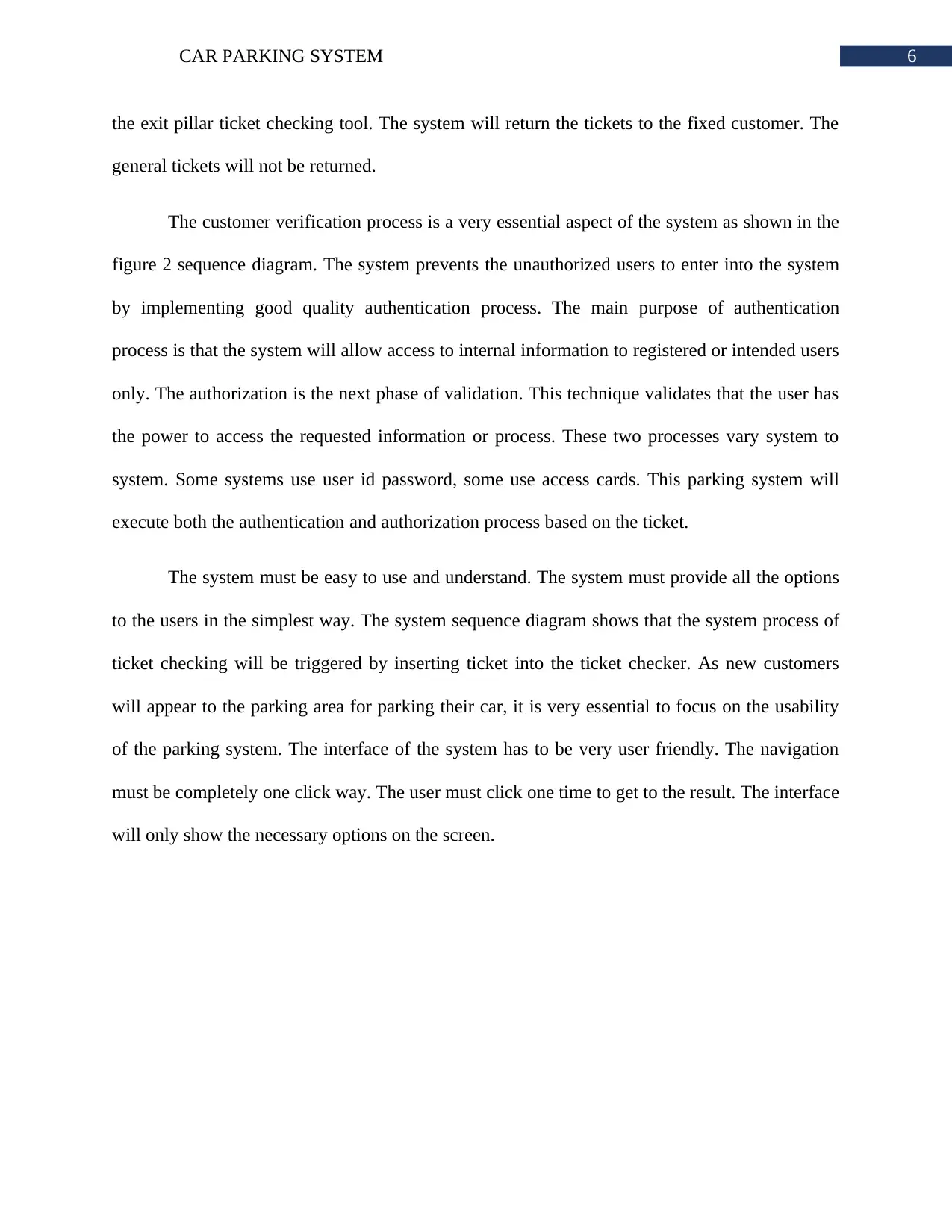
6CAR PARKING SYSTEM
the exit pillar ticket checking tool. The system will return the tickets to the fixed customer. The
general tickets will not be returned.
The customer verification process is a very essential aspect of the system as shown in the
figure 2 sequence diagram. The system prevents the unauthorized users to enter into the system
by implementing good quality authentication process. The main purpose of authentication
process is that the system will allow access to internal information to registered or intended users
only. The authorization is the next phase of validation. This technique validates that the user has
the power to access the requested information or process. These two processes vary system to
system. Some systems use user id password, some use access cards. This parking system will
execute both the authentication and authorization process based on the ticket.
The system must be easy to use and understand. The system must provide all the options
to the users in the simplest way. The system sequence diagram shows that the system process of
ticket checking will be triggered by inserting ticket into the ticket checker. As new customers
will appear to the parking area for parking their car, it is very essential to focus on the usability
of the parking system. The interface of the system has to be very user friendly. The navigation
must be completely one click way. The user must click one time to get to the result. The interface
will only show the necessary options on the screen.
the exit pillar ticket checking tool. The system will return the tickets to the fixed customer. The
general tickets will not be returned.
The customer verification process is a very essential aspect of the system as shown in the
figure 2 sequence diagram. The system prevents the unauthorized users to enter into the system
by implementing good quality authentication process. The main purpose of authentication
process is that the system will allow access to internal information to registered or intended users
only. The authorization is the next phase of validation. This technique validates that the user has
the power to access the requested information or process. These two processes vary system to
system. Some systems use user id password, some use access cards. This parking system will
execute both the authentication and authorization process based on the ticket.
The system must be easy to use and understand. The system must provide all the options
to the users in the simplest way. The system sequence diagram shows that the system process of
ticket checking will be triggered by inserting ticket into the ticket checker. As new customers
will appear to the parking area for parking their car, it is very essential to focus on the usability
of the parking system. The interface of the system has to be very user friendly. The navigation
must be completely one click way. The user must click one time to get to the result. The interface
will only show the necessary options on the screen.
Paraphrase This Document
Need a fresh take? Get an instant paraphrase of this document with our AI Paraphraser
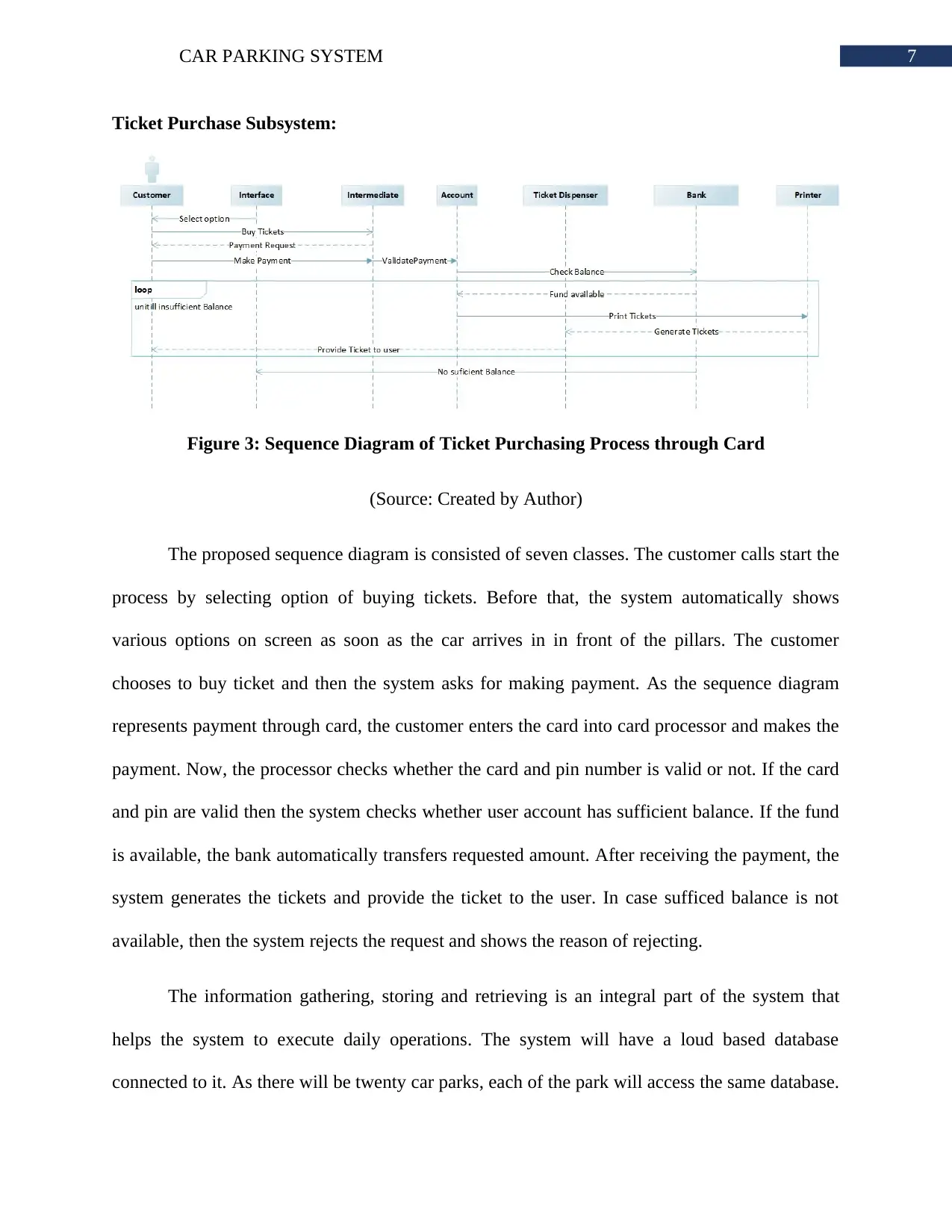
7CAR PARKING SYSTEM
Ticket Purchase Subsystem:
Figure 3: Sequence Diagram of Ticket Purchasing Process through Card
(Source: Created by Author)
The proposed sequence diagram is consisted of seven classes. The customer calls start the
process by selecting option of buying tickets. Before that, the system automatically shows
various options on screen as soon as the car arrives in in front of the pillars. The customer
chooses to buy ticket and then the system asks for making payment. As the sequence diagram
represents payment through card, the customer enters the card into card processor and makes the
payment. Now, the processor checks whether the card and pin number is valid or not. If the card
and pin are valid then the system checks whether user account has sufficient balance. If the fund
is available, the bank automatically transfers requested amount. After receiving the payment, the
system generates the tickets and provide the ticket to the user. In case sufficed balance is not
available, then the system rejects the request and shows the reason of rejecting.
The information gathering, storing and retrieving is an integral part of the system that
helps the system to execute daily operations. The system will have a loud based database
connected to it. As there will be twenty car parks, each of the park will access the same database.
Ticket Purchase Subsystem:
Figure 3: Sequence Diagram of Ticket Purchasing Process through Card
(Source: Created by Author)
The proposed sequence diagram is consisted of seven classes. The customer calls start the
process by selecting option of buying tickets. Before that, the system automatically shows
various options on screen as soon as the car arrives in in front of the pillars. The customer
chooses to buy ticket and then the system asks for making payment. As the sequence diagram
represents payment through card, the customer enters the card into card processor and makes the
payment. Now, the processor checks whether the card and pin number is valid or not. If the card
and pin are valid then the system checks whether user account has sufficient balance. If the fund
is available, the bank automatically transfers requested amount. After receiving the payment, the
system generates the tickets and provide the ticket to the user. In case sufficed balance is not
available, then the system rejects the request and shows the reason of rejecting.
The information gathering, storing and retrieving is an integral part of the system that
helps the system to execute daily operations. The system will have a loud based database
connected to it. As there will be twenty car parks, each of the park will access the same database.
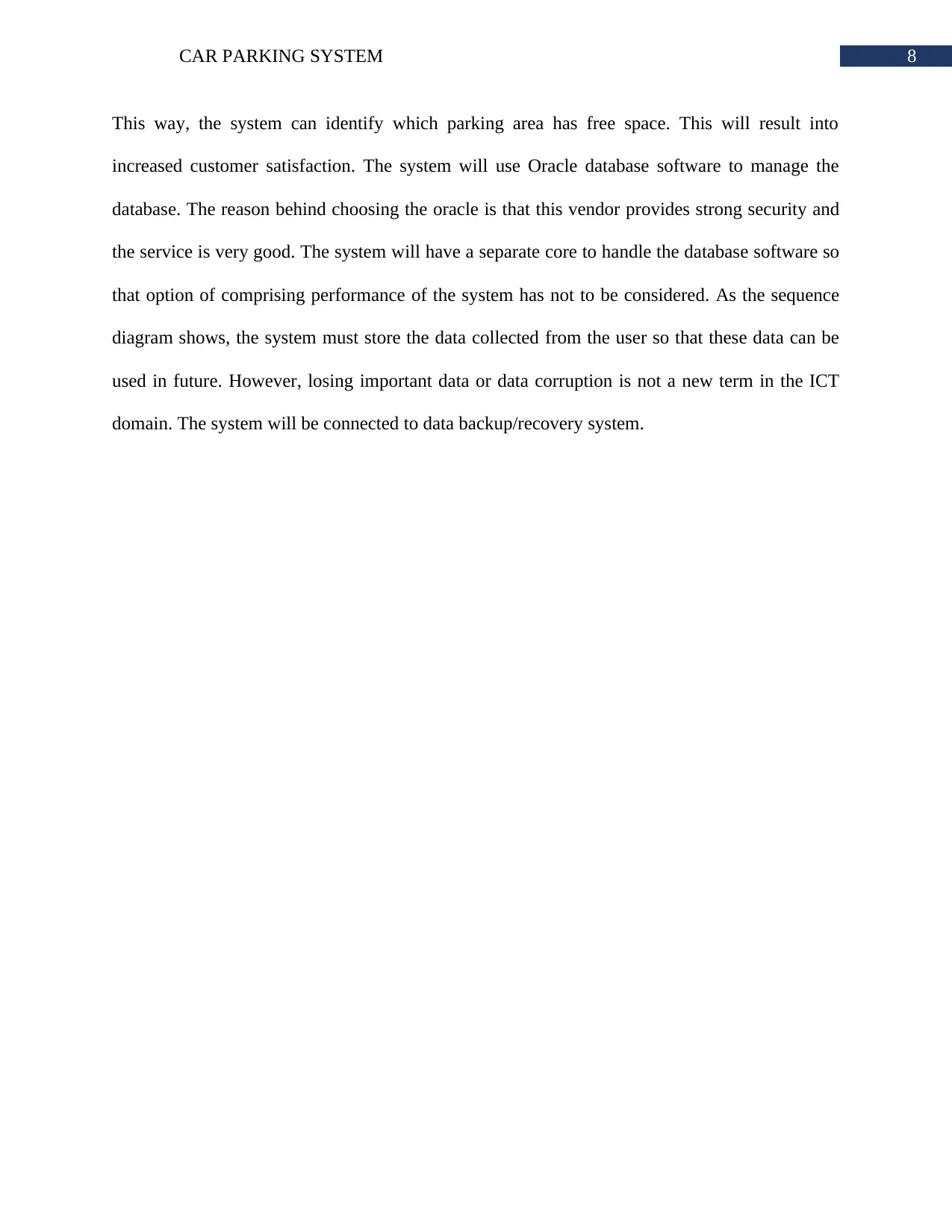
8CAR PARKING SYSTEM
This way, the system can identify which parking area has free space. This will result into
increased customer satisfaction. The system will use Oracle database software to manage the
database. The reason behind choosing the oracle is that this vendor provides strong security and
the service is very good. The system will have a separate core to handle the database software so
that option of comprising performance of the system has not to be considered. As the sequence
diagram shows, the system must store the data collected from the user so that these data can be
used in future. However, losing important data or data corruption is not a new term in the ICT
domain. The system will be connected to data backup/recovery system.
This way, the system can identify which parking area has free space. This will result into
increased customer satisfaction. The system will use Oracle database software to manage the
database. The reason behind choosing the oracle is that this vendor provides strong security and
the service is very good. The system will have a separate core to handle the database software so
that option of comprising performance of the system has not to be considered. As the sequence
diagram shows, the system must store the data collected from the user so that these data can be
used in future. However, losing important data or data corruption is not a new term in the ICT
domain. The system will be connected to data backup/recovery system.
⊘ This is a preview!⊘
Do you want full access?
Subscribe today to unlock all pages.

Trusted by 1+ million students worldwide
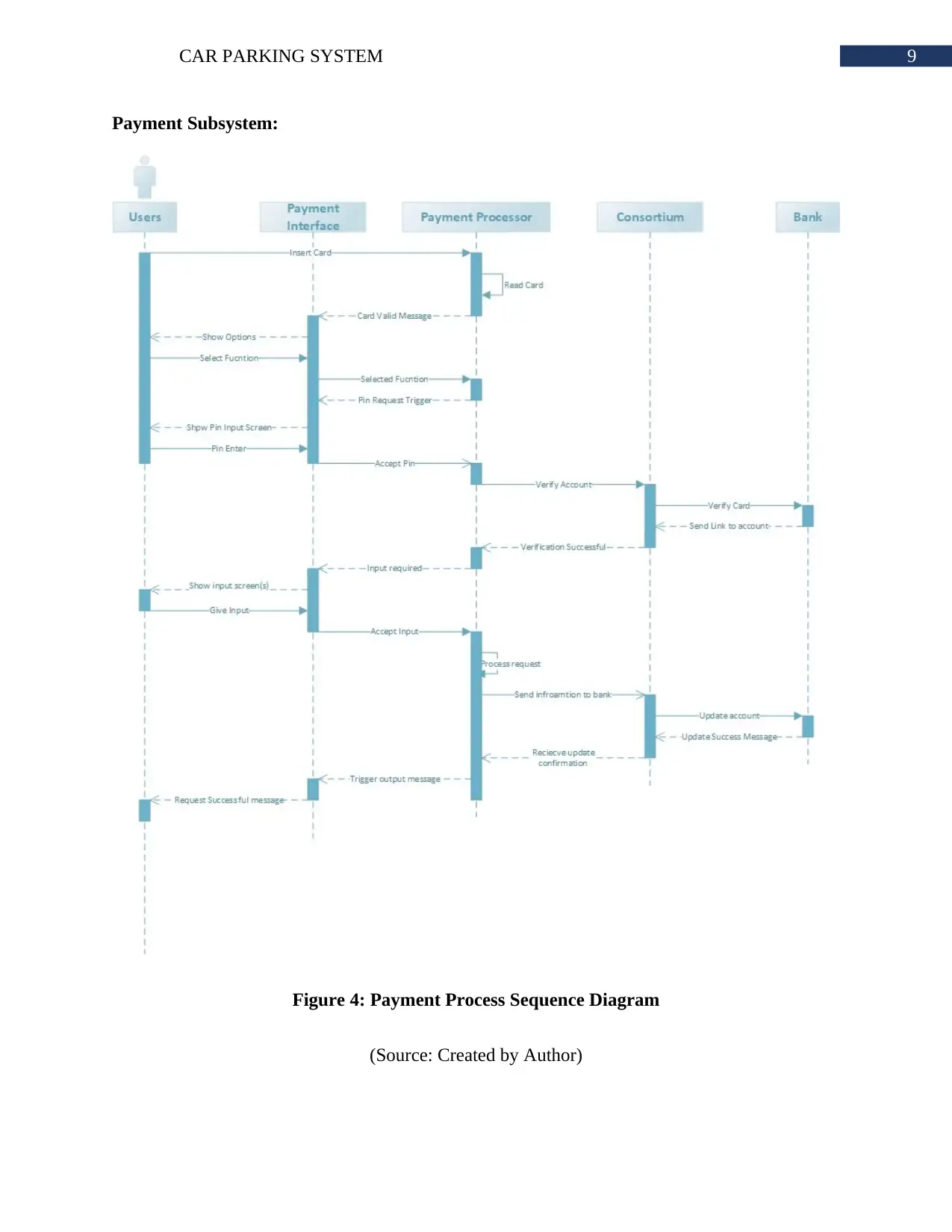
9CAR PARKING SYSTEM
Payment Subsystem:
Figure 4: Payment Process Sequence Diagram
(Source: Created by Author)
Payment Subsystem:
Figure 4: Payment Process Sequence Diagram
(Source: Created by Author)
Paraphrase This Document
Need a fresh take? Get an instant paraphrase of this document with our AI Paraphraser
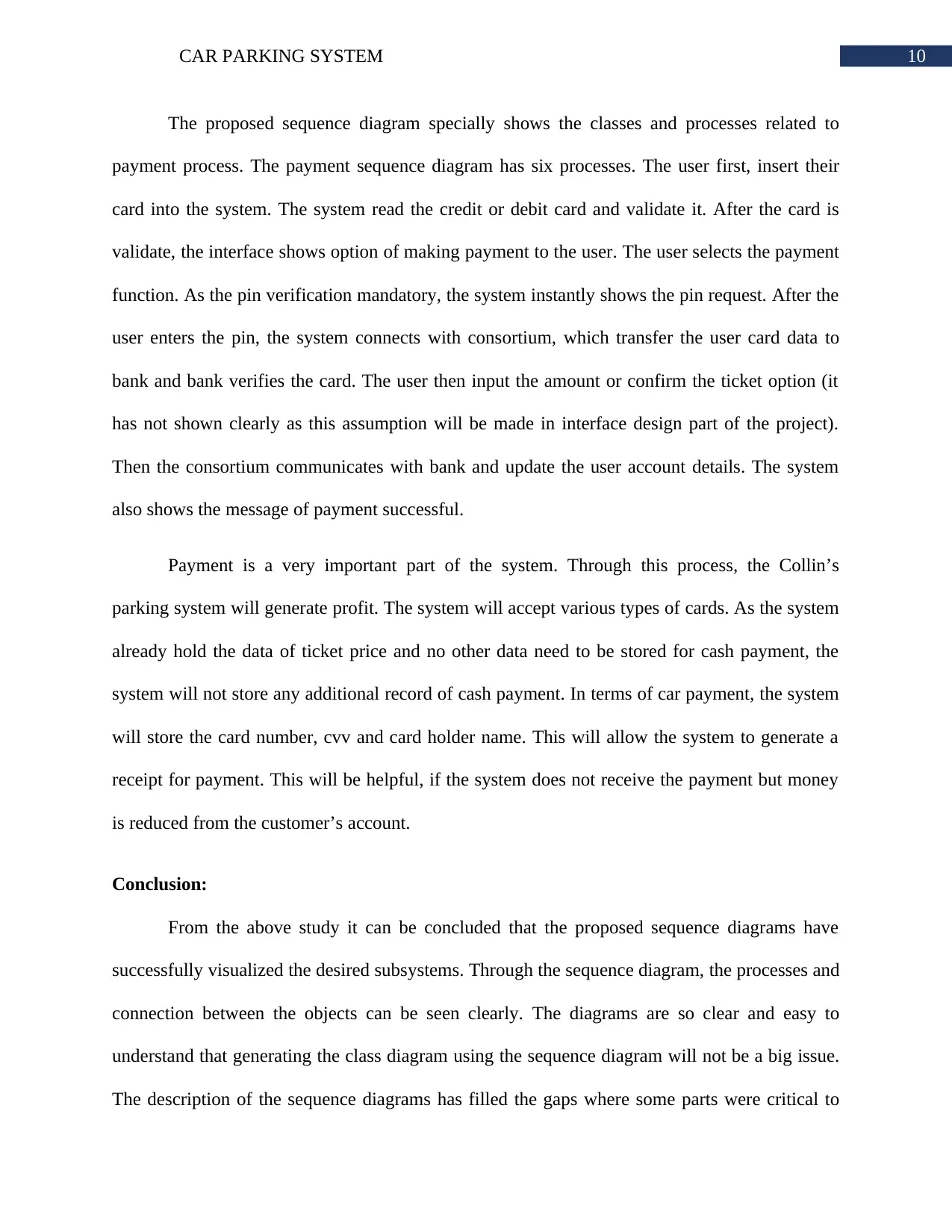
10CAR PARKING SYSTEM
The proposed sequence diagram specially shows the classes and processes related to
payment process. The payment sequence diagram has six processes. The user first, insert their
card into the system. The system read the credit or debit card and validate it. After the card is
validate, the interface shows option of making payment to the user. The user selects the payment
function. As the pin verification mandatory, the system instantly shows the pin request. After the
user enters the pin, the system connects with consortium, which transfer the user card data to
bank and bank verifies the card. The user then input the amount or confirm the ticket option (it
has not shown clearly as this assumption will be made in interface design part of the project).
Then the consortium communicates with bank and update the user account details. The system
also shows the message of payment successful.
Payment is a very important part of the system. Through this process, the Collin’s
parking system will generate profit. The system will accept various types of cards. As the system
already hold the data of ticket price and no other data need to be stored for cash payment, the
system will not store any additional record of cash payment. In terms of car payment, the system
will store the card number, cvv and card holder name. This will allow the system to generate a
receipt for payment. This will be helpful, if the system does not receive the payment but money
is reduced from the customer’s account.
Conclusion:
From the above study it can be concluded that the proposed sequence diagrams have
successfully visualized the desired subsystems. Through the sequence diagram, the processes and
connection between the objects can be seen clearly. The diagrams are so clear and easy to
understand that generating the class diagram using the sequence diagram will not be a big issue.
The description of the sequence diagrams has filled the gaps where some parts were critical to
The proposed sequence diagram specially shows the classes and processes related to
payment process. The payment sequence diagram has six processes. The user first, insert their
card into the system. The system read the credit or debit card and validate it. After the card is
validate, the interface shows option of making payment to the user. The user selects the payment
function. As the pin verification mandatory, the system instantly shows the pin request. After the
user enters the pin, the system connects with consortium, which transfer the user card data to
bank and bank verifies the card. The user then input the amount or confirm the ticket option (it
has not shown clearly as this assumption will be made in interface design part of the project).
Then the consortium communicates with bank and update the user account details. The system
also shows the message of payment successful.
Payment is a very important part of the system. Through this process, the Collin’s
parking system will generate profit. The system will accept various types of cards. As the system
already hold the data of ticket price and no other data need to be stored for cash payment, the
system will not store any additional record of cash payment. In terms of car payment, the system
will store the card number, cvv and card holder name. This will allow the system to generate a
receipt for payment. This will be helpful, if the system does not receive the payment but money
is reduced from the customer’s account.
Conclusion:
From the above study it can be concluded that the proposed sequence diagrams have
successfully visualized the desired subsystems. Through the sequence diagram, the processes and
connection between the objects can be seen clearly. The diagrams are so clear and easy to
understand that generating the class diagram using the sequence diagram will not be a big issue.
The description of the sequence diagrams has filled the gaps where some parts were critical to
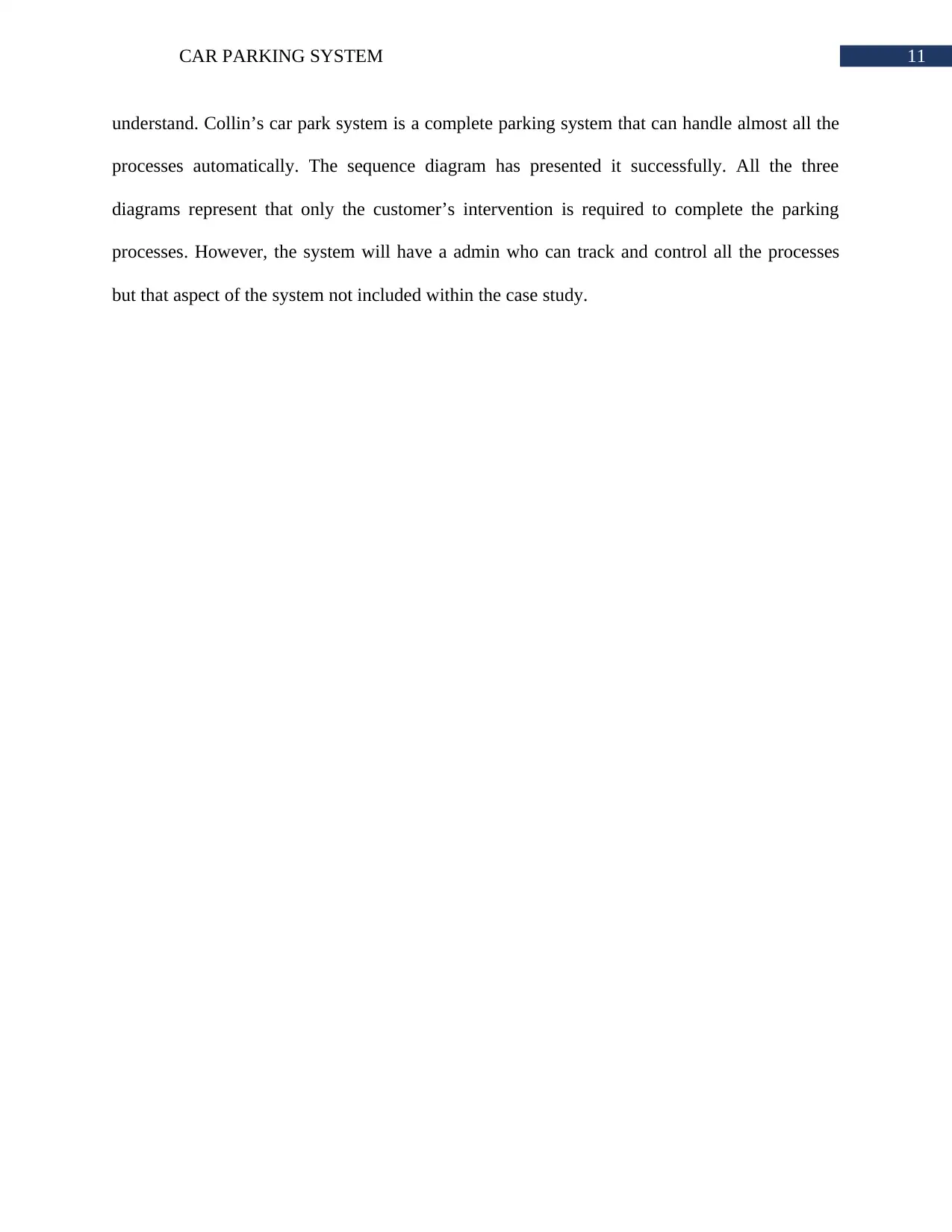
11CAR PARKING SYSTEM
understand. Collin’s car park system is a complete parking system that can handle almost all the
processes automatically. The sequence diagram has presented it successfully. All the three
diagrams represent that only the customer’s intervention is required to complete the parking
processes. However, the system will have a admin who can track and control all the processes
but that aspect of the system not included within the case study.
understand. Collin’s car park system is a complete parking system that can handle almost all the
processes automatically. The sequence diagram has presented it successfully. All the three
diagrams represent that only the customer’s intervention is required to complete the parking
processes. However, the system will have a admin who can track and control all the processes
but that aspect of the system not included within the case study.
⊘ This is a preview!⊘
Do you want full access?
Subscribe today to unlock all pages.

Trusted by 1+ million students worldwide
1 out of 14
Related Documents
Your All-in-One AI-Powered Toolkit for Academic Success.
+13062052269
info@desklib.com
Available 24*7 on WhatsApp / Email
![[object Object]](/_next/static/media/star-bottom.7253800d.svg)
Unlock your academic potential
Copyright © 2020–2025 A2Z Services. All Rights Reserved. Developed and managed by ZUCOL.





